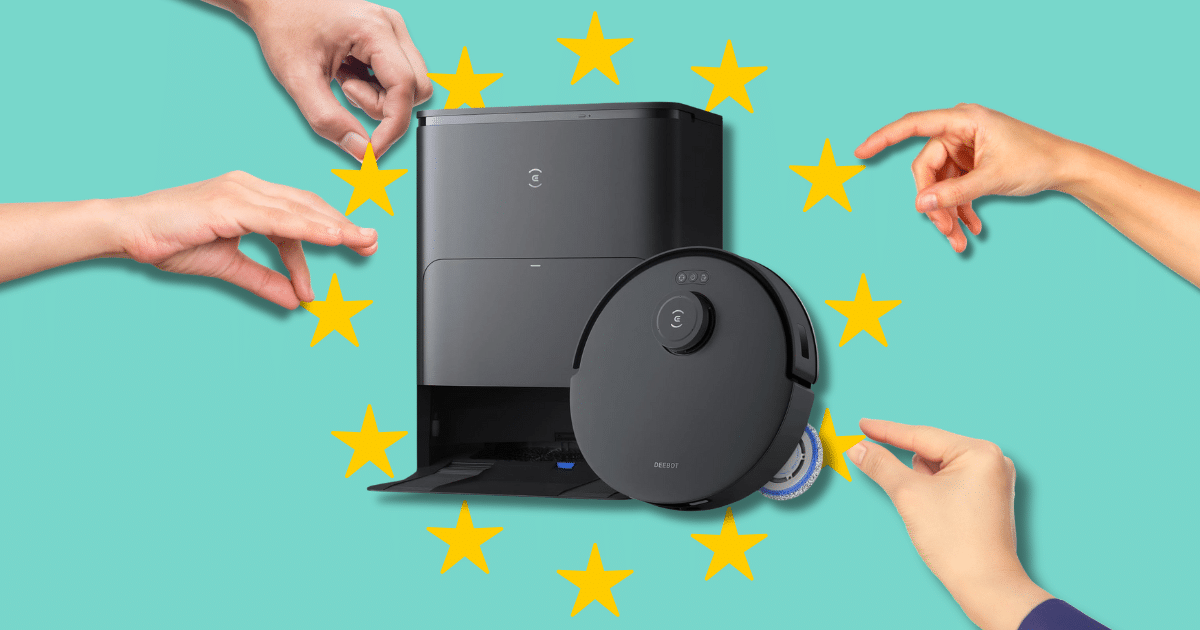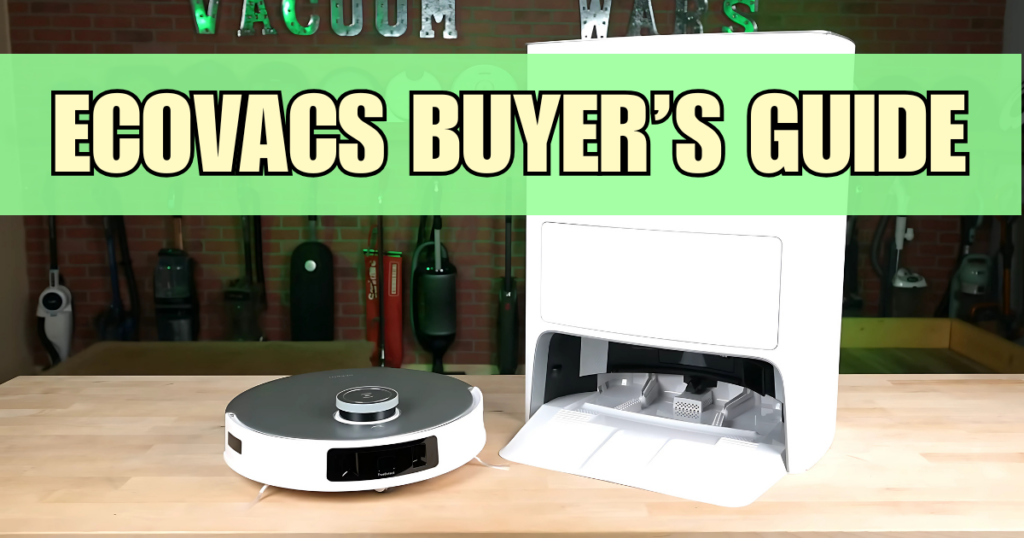We noticed something strange about Ecovacs’ Amazon reviews — and what we found raised bigger questions about authenticity.
We first noticed something unusual while reviewing Ecovacs’ Amazon listings, particularly for the Deebot X11 Omni. Many of the Ecovacs Amazon reviews—especially those with attached videos—felt… off, even though they carried the “Amazon Verified Purchase” badge (which only confirms the order was placed through Amazon). We saw the same floor patterns, identical room layouts, and matching camera angles appearing again and again, along with an unusually high number of uploads in a short window.
None of this alone proves anything. After all, robot vacuums like the X11 are often filmed on tile or laminate floors, and there are only so many ways to take a product photo of a disk-shaped vacuum. There’s complete plausible deniability.
However, given that Amazon’s algorithm heavily rewards reviews with media, we decided to dig deeper to understand what might be happening—and how authentic these reviews really are.
The Overview Numbers Didn’t Add Up
When we compared Ecovac’s recent launches to comparable products from Roborock or Dreame, we found a massive discrepancy right at the forefront of the data: The reviews were coming in much faster than normal, and a much higher percentage of them were the types of reviews that Amazon cares about: Media reviews which just so happened to be all positive.
To get a fair picture, we lined up the data side-by-side with just a single product comparison so you can see the pattern clearly:
| Data | Roborock Saros 10R -238 days | Ecovacs Deebot X11 - 32 days |
|---|---|---|
| Dates | Feb 10 – Oct 6 | Sep 4 – Oct 6 |
| Total Reviews | 213 | 154 |
| Reviews/Day | 0.9 / day (avg) | 4.8 / day (avg) |
| Reviews w/ Media | 53 (24.9%) | 120 (77.9%) |
| Reviews w/ Media / Day | 0.25 / day (avg) | 3.75 / day (avg) |
| Critical Reviews w/ Media | 10 (18.9% of media reviews) | 1 (0.8% of media reviews) |
Within just its first month, the X11 generated nearly five reviews a day and almost four out of five included media, which we know Amazon’s algorithm tends to weigh and promote most heavily. In contrast, Roborock’s steady accumulation looks more organic.
To be fair, new products often see early spikes, so we gathered what data was available (Amazon severely restricts precision search) and compared the ‘early days’ of the Roborock Saros 10R against the X11.
| Data | Roborock Saros 10R - 100 Days | Roborock Saros 10R - 32 Days | Ecovacs Deebot X11 - 32 Days |
|---|---|---|---|
| Dates | Feb 10 – May 21 | Feb 10 – Mar 14 | Sep 4 – Oct 6 |
| Total Reviews | 113 | N/A | 154 |
| Reviews/Day | 1.13 / day (avg) | N/A | 4.8 / day (avg) |
| Reviews w/ Media | 32 (28.3%) | 12 (N/A%) | 120 (77.9%) |
| Reviews w/ Media / Day | 0.32 / day (avg) | 0.37 / day (avg) | 3.75 / day (avg) |
| Critical Reviews w/ Media | 4 (12.5% of media reviews) | 2 (16.7% of media reviews) | 1 (0.8% of media reviews) |
Roborock performs better in comparison, but Ecovacs is so far ahead it’s suspicious. Within the same launch window, the X11 saw 10x as many media reviews. At this rate, even if the X11 stopped receiving ALL reviews, it would still take the Roborock’s product 39 weeks to catch up… and we’re only in the first month.
There is a possibility it’s just effective marketing, but it does look like a statistical anomaly. So, to further dig in, we also analyzed the content of the reviews themselves
For the rest of this investigation, we narrowed our focus to a single product: the Ecovacs Deebot X11 Omni. It’s the newest release, which means Amazon’s interface limits won’t get in the way compared to products with thousands of reviews.
Signs of Automation in Ecovacs’ Written Reviews
We reviewed every one of the 100 recent reviews that Amazon makes available, and at least 25 (25%) showed unmistakable signs of automation or templating. We suspect the real number is likely higher, and we’ll get into why below.
How We Looked for Patterns
First, we flagged suspicious reviews that showed the following signs:
- High keyword density of features.
- Use of branded technology like “OZMO Roller 2.0” or “PowerBoost charging”
- Unusual formatting, such as em-dashes used without spacing or perfectly balances paragraph weight (no heavy/light paragraphs).
Once flagged, we looked through the users other reviews to see if their other reviews follow a similar pattern, to eliminate users who might have writing quirks or be using AI in a writing capacity. If their other reviews showed the same pattern, it wasn’t labeled as “likely fake.”
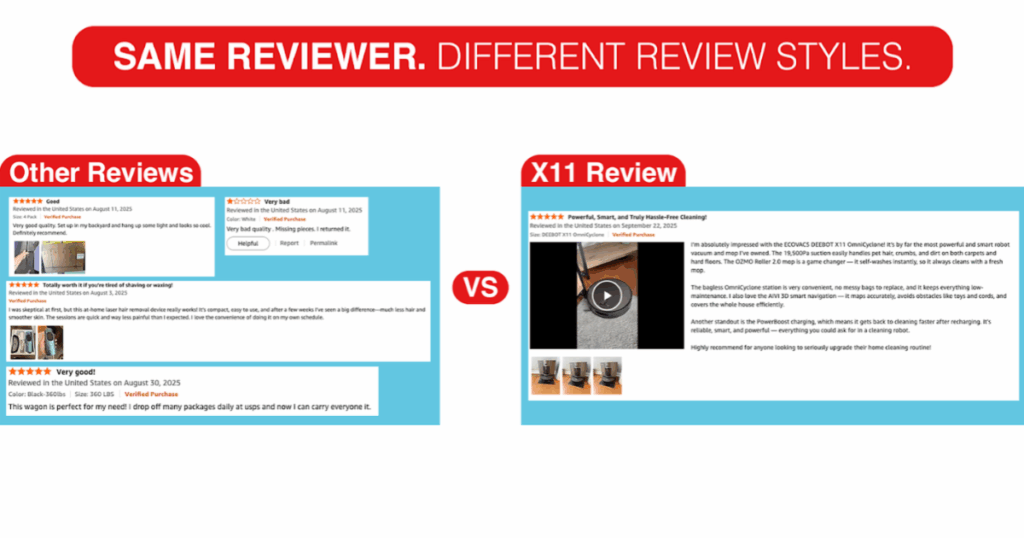
Of those that were likely fake, there are a few formulaic rhythms that read more like a commercial or press release than a testimonial. It usually looks like: [branded feature] means [benefit]
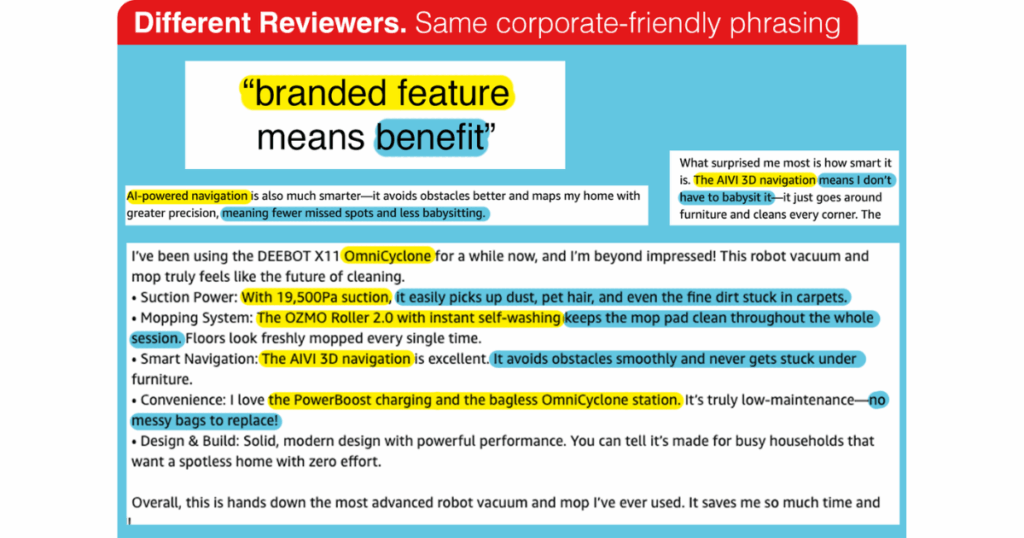
We were confident in the pattern, but a few reviews didn’t quite fit. In some cases, the language matched a templated or AI-like style almost perfectly, yet something still broke the mold. Below, we examine two case studies that help complete the picture. Even among reviews labeled “Amazon Verified Purchase,” we found inconsistencies between the written language and the video environments that warranted a closer look.
Case Studies – How Review Patterns Show Possible Automation
Case Study A: “Floating Punctuation” Reviewer
Written content
This user has a distinct writing style within other reviews. First they have a habit of isolated punctuation and uneven spacing. This is not a red flag, it’s a pretty common artifact in translation software or voice-to-text input. Combined with the loose English structure, it’s likely English is not this person’s first language.
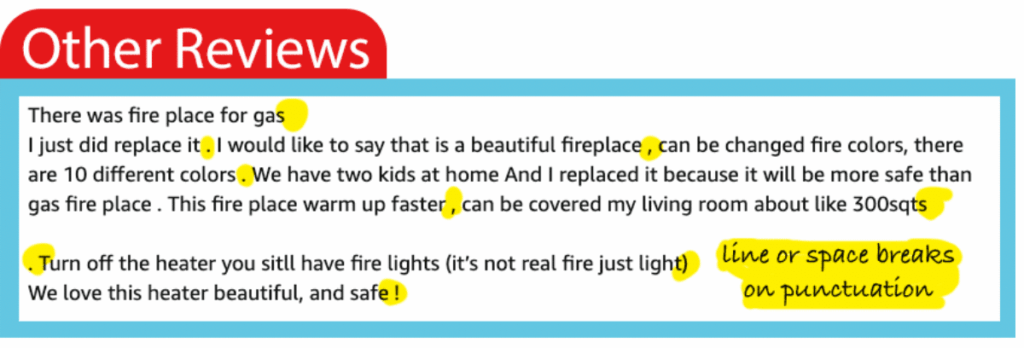
Yet the Ecovacs review suddenly introduces full fluency. They use complex sentences, an em dash (never used elsewhere), and polished spelling and structure. Clear red flag, but confusing: A few of their familiar punctuation hallmarks integrated into the otherwise out-of-place review.
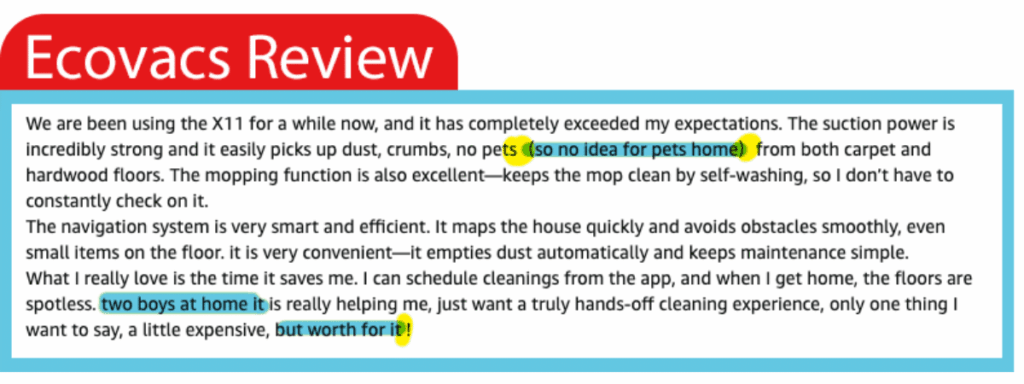
Takeaway: This is likely an AI-written review that was modified by the reviewer for personal honesty. The pieces that break the template are personalizations and disclaimers (two kids, no pets, expensive). Wouldn’t someone with no pets simply omit that detail? The most consistent explanation is that the review provided to them mentioned pet hair, and they modified it so they weren’t misrepresenting themselves.
Video content
Because Amazon tends to promote reviews that include photos or videos, a large number of media reviews can make a product seem more visible and popular on the site. To better understand how these writing patterns connected with their corresponding video reviews, we looked at a few reviewers more closely — and this was where things started to click. The flooring, molding, and wall combinations in some reviews didn’t match any of the rooms visible in their other product reviews.
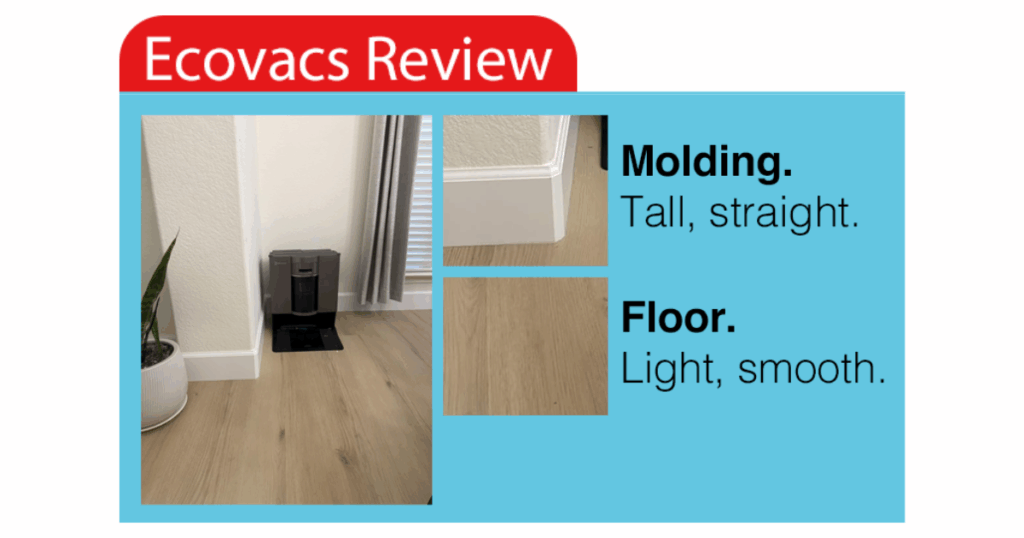
Every other review they’ve posted shows the same consistent home environment: identical floors, baseboards, and decor. But in this one for the DEEBOT X11, all of those details change. The floorboards have different tiling, and the molding doesn’t match what we see elsewhere.
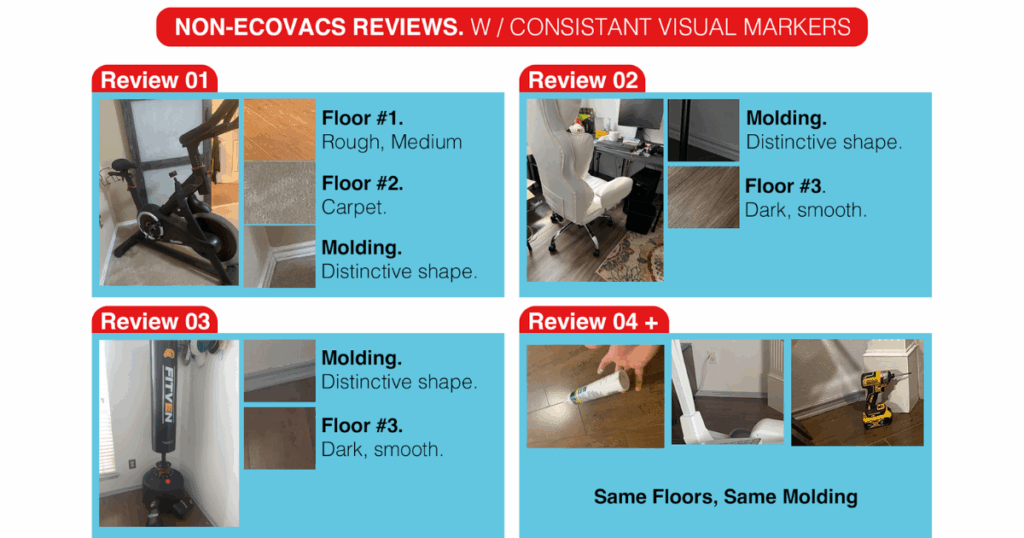
It’s incredibly unlikely this video was taken by the user themselves, at least in their own home. Of course, it’s possible that the reviewer had recently moved, so this is not proof that Ecovacs provided videos—just an interesting observation.
Case Study B “Backyard View” Reviewer
Written Content
This user was flagged due to their writing style.
- Used em dashes without spaces.
- Mentioned branded features by name.
- Bulleted list.
- Wrote in marketing speak.
In fact, this is one of the reviewers mentioned above (where we talked about [feature] [benefit] templating).

None of their writing from other reviews included any of the above features, which makes the written portion of the review stand out as likely AI generated.
However, this case study is a particular head-scratcher because of the video component.
Video Content
The video they filmed is not only user made, it’s one of the most authentic videos we’ve seen during this entire investigation. Although there’s no talking, the environment is so distinctive that it can’t be stock.
Digging through their other reviews confirms that this is indeed shot from where they live, as similar elements are seen in other videos and images going back at least a year.

Conclusion: Although the written AI content looks fake, this video appears completely authentic. So why the discrepancies? What’s going on here?
Connecting the Dots – A Coordinated Review Pattern?
Looking at these two reviewers side by side tells the story. In one case, we have a likely fake video paired with a human-modified review. In the other, a real video paired with a likely AI-written review. Two sides of the same coin… and together, they may tell a bigger story.
It appears that reviewers may have been provided three assets: the product itself, a prewritten (AI-generated) review, possibly stock media photographed in advance by Ecovacs or a marketing partner. Each participant posted some combination of those materials. They either:
- Uploaded both the stock media and the copy verbatim.
- Used either the media or the text, providing the other half themselves.
- Modified one or all of the provided assets to sound more personal or make them more honest.
- Wrote the review and took the media themselves, rejecting the provided materials.
Because of the above variants, it’s impossible to know how many of these reviews are organic. But given the volume of suspicious media activity, the inconsistencies in writing style, and the statistical anomalies in review rates, it would not be unreasonable to conclude that a significant majority of these media reviews, potentially up to 9 out of 10 of the early reviews, were incentivized or coached.
Every one of these posts is marked “Amazon Verified Purchase,” which means the product was technically bought through Amazon. That doesn’t make it legitimate, though. If a user received the product at a discount, rebate, or reimbursement in exchange for posting a review (especially one using pre-supplied media or language) that’s a direct violation of Amazon’s terms of service.
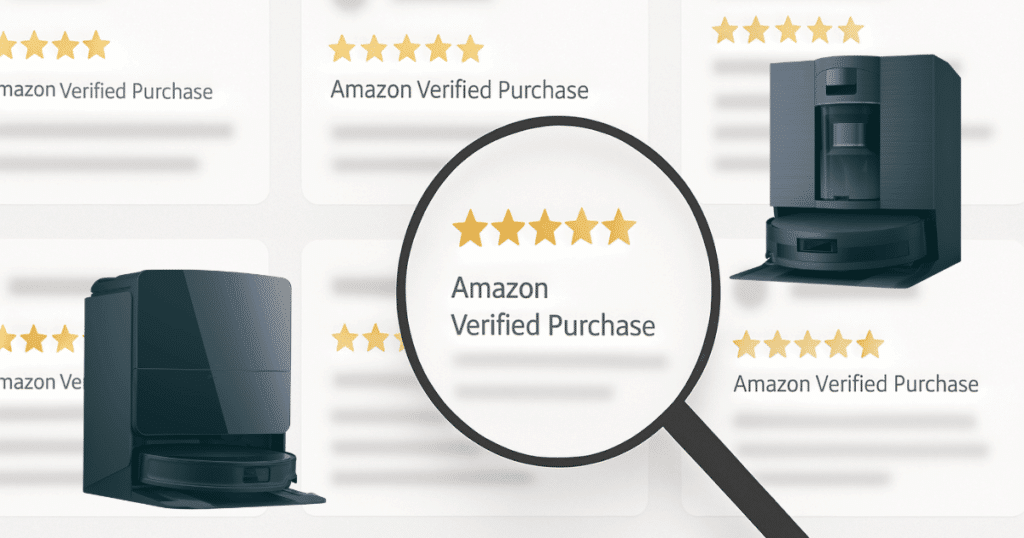
What Ecovacs’ Amazon Reviews Really Show
Overall, our analysis of Ecovacs’ Amazon reviews—including the Deebot X11 Omni—reveals consistent patterns that suggests coordination or review manipulation. We don’t have direct proof, but the signals around authenticity are present.
To be clear, we do have to give a disclaimer here: we found no evidence of deliberate misconduct by Ecovacs. A third-party marketing or review-curation service may have provided customers with discounted units, suggested language, or pre-shot media. If so, this could have occurred without Ecovacs’ knowledge, indicating a lack of oversight rather than malice.
What is clear is the outcome: hundreds of “Amazon Verified Purchase” five-star reviews—many with similar phrasing and visuals—shaping how these products appear on the platform. We’ll continue monitoring, but at this time the numbers, language, and media patterns are consistent with a coordinated effort to enhance Ecovacs’ visibility on Amazon.
Related resources
Ecovacs Robot Vacuum Buyers Guide 2025
We break down the most important differences across the Ecovacs robot vacuum lineup. From affordable models to advanced units packed with high-tech features, we’ll help you figure out which upgrades are worth investing in and which ones you might not need. Whether you’re shopping for a smart cleaning assistant on a budget or looking to splurge on a premium option, our guide will walk you through everything you need to know to find the right Ecovacs robot vacuum for your home. See the Guide
